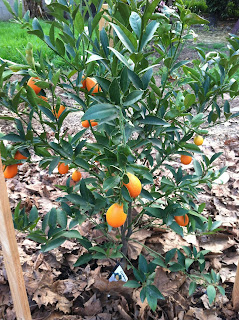In
a post last week, we talked about winter squash (including pumpkins)--weird, warty, wonderful winter squash (including pumpkins). Hopefully by now you've all come to share my obsession and have acquired a storage shed full of squash. So go get a few; it's time to butcher 'em, cook 'em, and puree 'em.
Why, you ask, are we murdering innocent squash? Simple--because they're delicious! Our goal will be pureed squash, which can be used in lots of ways, which we'll explore in our next post.
Let's get started! You will need:
- A pumpkin or other winter squash (or 2 or 10 depending on the size of your oven and your squash). Note: you can use pumpkins and winter squash interchangeably in recipes, but you'll get the best results with winter squash or cooking/pie pumpkins. The big jack o'lantern pumpkins can be a bit stringy or watery, and they don't always have the nice orange color we expect from cooked pumpkins. But you can use them if you want.
- An oven
- A big ol' Norman Bates Psycho knife (any large, sharp kitchen knife will do)
- A smaller, sharp paring knife
- A baking sheet
- Some foil
- A fork
- A blender or food processor
- Freezer containers or bags
First, wash your squash (hey, that has a nice rhythm to it...). You want to remove any dirt or other gunk, so you don't get your baking sheet all dirty. Then line your baking sheet with foil to make cleanup easier.
Now, put your first victim...er, I mean squash, on a solid surface like a kitchen counter or cutting board, and cut it into pieces. The smaller the pieces, the faster they'll cook, but cutting squash is hard work, so bigger pieces are easier. Here's what mine usually look like:
Put the pulp and seeds in a big bowl. We'll come back to that.
Put the pieces cut side down on the foil-lined baking sheet. Why cut side down? Because if you put them cut side up, they'll develop a leathery coating on the outside that won't make a nice, smooth puree.
Cut as many squash as your baking sheets and oven will hold. I cook two baking sheets at a time, because I have two oven racks.
Set your oven for 350F and bake the squash for about 90 minutes, then check to see if it's done. How do you check to see if it's done? You stab it with a big fork! (C'mon... What did you expect? A gentle stroking? This is my blog after all.) If it's done, it will be very tender. If it isn't very tender, cook it awhile longer, stabbing it every 20 minutes or so till it's done.
When the squash is done, take it out of the oven and let it sit till it's cool enough for you to touch. You can leave it out overnight if you want; just cover it with a towel so no dust or gnats get on it.
Once it has cooled, grab your paring knife, peel the squash, and cut it into small chunks. Throw the chunks into a blender or food processor and puree till smooth.
Package the puree for freezing and (of course) freeze it. I usually use canning jars for freezing, but you can use freezer containers or freezer bags. I usually package my squash puree in pints, because most recipes only call for a cup or two of pumpkin/squash. If you want to freeze your puree in recipe-sized amounts, you can put a cup of puree in a sandwich bag, then put the sandwich bags in a gallon freezer bag. But that uses lots of plastic, which is a bit wasteful unless you wash and reuse your bags.
That's it!
But wait! What about the seeds? Squash seeds can be cooked just like pumpkin seeds, and they're just as yummy. Everyone seems to have their own favorite method for roasting pumpkin seeds; just search online if you need ideas.






.JPG)
.JPG)





 Breaking news: we have ripe tomatoes! We've had cherry tomatoes for a couple of weeks now, but we didn't get our first full-sized tomato till a couple of days ago. Now we can have fresh tomato sauce, thick slices of tomato on burgers, margherita pizza, and today's afternoon treat: bruschetta. A couple of weeks ago, I had a wonderful heirloom tomato bruschetta at Pop Champagne Bar in Pasadena and decided I'd make it at home as soon as I had ripe tomatoes. I didn't exactly duplicate Pop's recipe, but it was still pretty good. Here's what I did; feel free to adapt to your own tastes. Garlic lovers may want to add some fresh minced garlic to the tomato mixture.
Breaking news: we have ripe tomatoes! We've had cherry tomatoes for a couple of weeks now, but we didn't get our first full-sized tomato till a couple of days ago. Now we can have fresh tomato sauce, thick slices of tomato on burgers, margherita pizza, and today's afternoon treat: bruschetta. A couple of weeks ago, I had a wonderful heirloom tomato bruschetta at Pop Champagne Bar in Pasadena and decided I'd make it at home as soon as I had ripe tomatoes. I didn't exactly duplicate Pop's recipe, but it was still pretty good. Here's what I did; feel free to adapt to your own tastes. Garlic lovers may want to add some fresh minced garlic to the tomato mixture.
